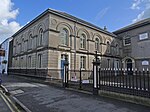Carmarthen
CarmarthenCommunities in CarmarthenshireCounty towns in WalesLocations associated with Arthurian legendMonasteries dissolved under the English Reformation ... and 4 more
Pages with Welsh IPAStaple portsTowns in CarmarthenshireUse British English from September 2017

Carmarthen (, RP: ; Welsh: Caerfyrddin [kairˈvərðɪn], "Merlin's fort" or "Sea-town fort") is the county town of Carmarthenshire and a community in Wales, lying on the River Towy 8 miles (13 km) north of its estuary in Carmarthen Bay. The population was 14,185 in 2011, down from 15,854 in 2001, but gauged at 16,285 in 2019. It has a claim to be the oldest town in Wales – Old Carmarthen and New Carmarthen became one borough in 1546. It was the most populous borough in Wales in the 16th–18th centuries, described by William Camden as "chief citie of the country". Growth stagnated by the mid-19th century as new settlements developed in the South Wales Coalfield.
Excerpt from the Wikipedia article Carmarthen (License: CC BY-SA 3.0, Authors, Images).Carmarthen
Picton Terrace,
Geographical coordinates (GPS) Address Nearby Places Show on map
Geographical coordinates (GPS)
| Latitude | Longitude |
|---|---|
| N 51.856 ° | E -4.316 ° |
Address
Fitness Equipment
Picton Terrace
SA31 3DG , Carmarthen
Wales, United Kingdom
Open on Google Maps









